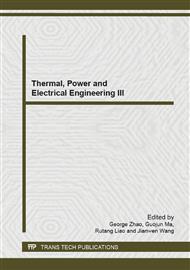[1]
Xie Heping, Xie Linzhi, Wang Yufei, Zhu Jiahua, Liang Bin, Ju Yang. [J]. JOURNAL OF SICHUAN UNIVERSITY, 2012, 44(4): 1-5 (In Chinese).
Google Scholar
[2]
Graves C, Ebbesen S D, Mogensen M, Lackner K S. [J]. Renewable and Sustainable Energy Reviews, 2011, 15(1): 1-23.
Google Scholar
[3]
K. S. Lackner, Thermodynamics of the Humidity Swing Driven Air Capture of Carbon Dioxide, GRT LLC[C], Tucson, AZ , (2008).
Google Scholar
[4]
Wang Tao, Lackner K S, Wright A B. [J]. Phys. Chem. Chem. Phys., 2013, 15: 504-514.
Google Scholar
[5]
Wang T. Fuel Synthesis with CO2 Captured from Atmosphere: Thermodynamic Analysis/ECS Transactions[C], Boston: Volume 41, (2011).
Google Scholar
[6]
Jensen S H, Larsen P H, Mogensen M. [J]. International Journal of Hydrogen Energy, 2007, 32(15): 3253-3257.
Google Scholar
[7]
Wang T, Lackner K S, Wright A. [J]. Environmental Science Technology, 2011, 45: 6670-6675.
Google Scholar
[8]
Lackner K S. [J]. The European Physical Journal Special Topics, 2009, 176(1): 93-106.
Google Scholar
[9]
Zeman F. J]. Environmental Science Technology, 2007, 41: 7558-7563.
Google Scholar
[10]
Mahmoudkhani M, Keith D W. [J]. International Journal of Greenhouse Gas Conversion, 2009, 3(4): 376-384.
Google Scholar
[11]
Nikulshina V, Ayesa N, Galvez M E, Steinfeld A. [J]. Chemical Engineering Journal, 2008, 140(1-3): 62-70.
Google Scholar
[12]
Goeppert Alain, Czaun Miklos, Surya Prakash G K, Olah G A. [J]. Energy Environ. Sci., 2012, 5: 7833-7853.
Google Scholar
[13]
Kohl A, Nielsen R. Gas Purification [M]. 5th edition. Houston: Gulf Publishing Company, 1997: 95-103.
Google Scholar
[14]
Yildiz B, Kazimi M S. [J]. International Journal of Hydrogen Energy, 2006, 31(1): 77-92.
Google Scholar
[15]
Avila-Marin A. L. [J]. Solar Energy, 2011, 85(5): 891-910.
Google Scholar
[16]
Smith J M, Ness H C V, Abbott M M. Introduction to chemical engineering thermodynamics [M]. 6th edition. Boston: McGraw-Hill, 2001: 631-689.
Google Scholar
[17]
Elimelech M, Phillip W A. [J]. Science, 2011, 333: 712-717.
Google Scholar
[18]
Rosen M A, Scott D S. [J]. International Journal of Hydrogen Energy, 1992, 17(3): 199-204.
Google Scholar
[19]
M. Ranjan and H. J. Herzog[J]. Energy Procedia, 2011, 4: 2869-2881.
Google Scholar
[20]
Direct Air Capture of CO2 with Chemicals [M], The American Physical Society, College Park, MD, (2011).
Google Scholar
[21]
Hinkley J T, O'Brien J A, Fell C J, Lindquist S-E. [J]. International Journal of Hydrogen Energy, 2011, 36(18): 11596-11603.
DOI: 10.1016/j.ijhydene.2011.06.048
Google Scholar
[22]
Takai T, Kubo S, Nakagiri T, Inagaki Y. [J]. International Journal of Hydrogen Energy, 2011, 36(8): 4689-4701.
Google Scholar
[23]
Khaselev O, Turner J A. [J]. Science, 1998, 280(5362): 425-427.
Google Scholar
[24]
Hanagata N, Takeuchi T, Fukuju Y, Barnes D J, Karube I. [J]. Phytochemistry, 1992, 31(10): 3345-3348.
DOI: 10.1016/0031-9422(92)83682-o
Google Scholar
[25]
Kodama M, Ikemoto H, Miyachi S. [J]. J. Mar. Biotechnol., 1993, 1: 21-25.
Google Scholar
[26]
Kativu E, Hildebrandt D, Matambo T, Glasser D. [J]. ENVIRONMENTAL PROGRESS & SUSTAINABLE ENERGY, 2012, 31(1): 24-28.
DOI: 10.1002/ep.10600
Google Scholar
[27]
Wilson S A, Barker S L L, Dipple G M, Atudorei V. [J]. Environmental Science Technology, 2010, 44(24): 9522-9529.
Google Scholar
[28]
Zhan Z, Kobsiriphat W, Wilson J R, Pillai M, Kim I, Barnett S A. [J]. Energy & Fuels, 2009, 23: 3089-3096.
DOI: 10.1021/ef900111f
Google Scholar


